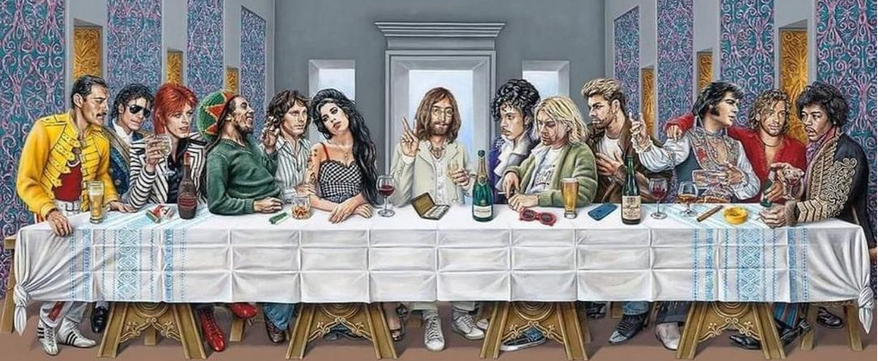
Sam Rivers was an American musician and singer best known as the bassist, backing vocalist, and co-founder of the nu-metal band Limp Bizkit.
His passing at the age of 48 marked the end of a chapter in a genre he helped define, but his influence and legacy are far from over. In this profile I’ll explore his life and work in detail: his early years, rise to fame with Limp Bizkit, musical style and contributions, personal struggles and triumphs, final years, and his enduring legacy.
Early Life and Musical Beginnings
Sam Rivers was born on September 2, 1977, in Jacksonville, Florida. From an early age he gravitated toward music: in middle school he played the tuba in the Arlington Middle School band before switching instruments. According to some sources, he took up guitar for a time, then changed to bass at the suggestion of a music teacher.
It was at this early stage that Rivers met drummer John Otto (they had believed at first to be cousins, though later discovered they were not) and began exploring more rock-oriented music. Meanwhile in Jacksonville the local scene was infused with hip-hop, punk, metal and skate culture — all of which would feed into Rivers’s later musical voice.
One anecdote often repeated: Rivers met vocalist Fred Durst while working at a Chick-fil-A in a mall in Jacksonville Beach. They discovered common interests in skateboarding and music, and that chance meeting helped spark what would become Limp Bizkit.
Thus, by his late teens Sam Rivers was firmly on a path toward becoming a founding member of a band that would become a major player in the late-1990s/early-2000s nu-metal movement.
Formation of Limp Bizkit and Rise to Fame
In 1994, Rivers, Durst and Otto came together and formed a band, which later evolved into Limp Bizkit. Rivers was instrumental in assembling the lineup: he suggested Otto as drummer and helped recruit guitarist Wes Borland as the group took shape.
Limp Bizkit’s early years were marked by a blend of rap, metal, punk and funk grooves — part of the emerging nu-metal wave. Rivers’s bass playing added a groove foundation that anchored the band’s heavy yet accessible sound. Their debut album, Three Dollar Bill, Y’all$ (1997) featured Rivers at age 19 on bass.
But it was the 1999 album Significant Other and the 2000 blockbuster Chocolate Starfish and the Hot Dog Flavored Water that launched Limp Bizkit into mainstream success. They sold millions of records worldwide, blending riffs, DJ scratches, rap vocals and groove-laden rhythm sections. Rivers’s bass provided a firm core to songs like “Nookie”, “Break Stuff” and “Rollin’”.
.
From a musical vantage point, Rivers’s role was more than simply “bass player”: among fans and critics his contributions are seen as helping define the groove and character of Limp Bizkit’s sound. For example, his interplay with Otto’s drums, his occasional backing vocals, and his sense of rhythm and timing gave the band a musical depth that sometimes went underappreciated.
By the early 2000s Limp Bizkit were at the height of their power: major tours, chart-topping albums, crossover appeal between rock and rap audiences. Rivers was in his early 20s but already part of a phenomenon.
Musical Style and Contributions
Sam Rivers’s bass style reflected his diverse influences and the hybrid nature of the band. Though not always the most flashy player in terms of virtuosic solos, his strengths lay in groove, feel, tone and consistency. Sources mention that he used finger-style more than pick, and that his bass tones were thick, punchy and well suited to the band’s heavy yet melodic textures.
One Wikipedia entry lists his influences as including the Jackson 5 (for groove and melody), Les Claypool, and Yanni (for melodic sensibility) — an interesting mix that reflects Rivers’s approach of combining groove and heaviness.
He was also acknowledged by the Gibson Awards in 2000 as “Best Bass Player”.
In terms of equipment, Rivers used various basses over his career. He was initially endorsed by Ibanez, then used customized Warwick basses (including a five-string variant with LEDs in the fretboard), and later live used five-string Fender Jazz Basses.
Musically, his presence allowed Limp Bizkit to exploit dynamics: groove-based verses, heavy riff-laden choruses, rap-rock transitions — Rivers’s bass bridged the aggressive and the accessible. When the band took a somewhat different direction on Results May Vary (2003) — including songs where Rivers himself played both guitar and bass — it showed his versatility.
While the spotlight often fell on frontman Fred Durst or guitarist Wes Borland (with his visual and sonic flamboyance), many longtime fans and bass-guitar communities emphasize that Sam Rivers was “undervalued” but deeply important. Example: on Reddit, a user writes:
“His work was not given the respect it deserves … the bass lines were a huge part of why those songs hit so hard.”
Thus Rivers’s contribution may be somewhat understated in popular discourse, but his musical peers and attentive listeners recognize his significance.
Personal Struggles and Hiatus
Behind the scenes, Rivers faced significant personal and health challenges. Though the public story when he left the band in 2015 cited degenerative disc disease, in 2020 Rivers revealed that his real reason for leaving was serious liver disease caused by excessive drinking.
He stated that he had been diagnosed around 2011, battled alcohol dependency, quit drinking, relapsed, and eventually underwent a liver transplant — the “perfect match” according to Rivers.
This interruption was significant: after leaving in 2015, he rejoined Limp Bizkit in 2018. During his time away, he also engaged in production work for local bands in Jacksonville and co-founded the side project Sleepkillers, which released its debut in 2019.
Rivers’s comeback illustrated his resilience: surviving a major transplant, returning to touring and recording, and continuing to contribute to his band’s activities. At the same time, his struggles highlight the toll that life on the road, heavy touring and lifestyle pressures can take even on successful musicians.
Later Years and Final Work
After his return in 2018, Sam Rivers continued with Limp Bizkit, participating in tours and recordings. The band’s 2021 album Still Sucks featured him. In 2025, he and the band remained active; he performed at major festivals (e.g., a show in Leeds, UK in August 2025) and was preparing for further engagements.

.
Sadly, on October 18, 2025, Sam Rivers died. The band announced his passing via social media, calling him “our brother. Our bandmate. Our heartbeat.” No official cause of death was stated at the time of announcement, though his past liver transplant and health issues have been mentioned in speculation.
In their tribute the band wrote:
“Sam Rivers wasn’t just our bass player — he was pure magic. The pulse beneath every song, the calm in the chaos, the soul in the sound.”
His passing was mourned by fans worldwide, fellow musicians, and the broader rock community, marking an end to an era of one of nu-metal’s enduring figures.
Legacy and Influence
Sam Rivers leaves behind a legacy on several fronts:
Musical Impact
- As a founding member of Limp Bizkit, Rivers helped shape the sound and success of one of nu-metal’s most commercially successful bands.
- His bass playing—groove-oriented, melodic yet heavy—provided a foundation that allowed rap-metal hybrids to thrive beyond novelty into sustained popularity.
- Many bass players in rock and metal cite his lines (e.g., on “Nookie”, “Break Stuff”, “Rollin’”) as formative influences. As one forum user noted:
“Easily the most underrated member of Limp Bizkit… the reason I started playing.”
Cultural Significance
- Limp Bizkit’s crossover success (rock + rap) in the late ‘90s and early ‘00s owes a great deal to their rhythmic groove and accessible heaviness—areas in which Rivers excelled.
- The band’s global tours and high-profile releases brought alternative metal into mainstream consciousness; Rivers was part of that wave.
Personal Resilience
- His battle with liver disease and his comeback show a story of struggle, survival and return which adds depth to his musical narrative.
- His willingness to continue contributing—rather than retiring quietly—speaks to his dedication to music and to his bandmates.
Underrated Status
- Although frontmen and guitarists often receive the bulk of public recognition, Rivers’s reputation among musicians and dedicated fans is that of a quietly influential figure—“the pulse beneath every song.”
- In future bass histories and retrospectives, his name is likely to be elevated further.
Posthumous Recognition
- With his passing in 2025, there will inevitably be renewed focus on his career, perhaps reissues, documentaries or retrospective compilations. The genre of nu-metal is also undergoing re‐evaluation, and Rivers’s contributions may be seen in a new light.
Reflections and Anecdotes
It is worth reflecting on a few human aspects of Sam Rivers’s journey that give texture to his profile:
- The story of meeting Fred Durst at a fast-food outlet and then forming a band speaks to how serendipity and shared passion can catalyse creative ventures.
- His initial role playing tuba and then guitar before settling on bass suggests a musician who experimented, learned, and evolved his craft rather than simply stepping into a role.
- The fact that he walked away from the band when his health forced him, and then returned, underscores a principle: you cannot separate the personal from the musical. Musical careers often come with personal costs, and Rivers’s story reminds us of that.
One Reddit user captured the personal impact of Rivers’s playing:
“I started playing bass because I listened to Limp Bizkit and Sam Rivers and realized the bass can be a cool instrument.”
Such testimonials reflect the influence Rivers had beyond chart positions: he inspired people to play instruments, to engage with music on a deeper level.
His modest, calm personality contrasts with the often theatrical image of nu-metal. He didn’t seek the spotlight in the way some frontmen do, but he anchored the band with humility and professionalism. That combination—musical fire plus personal steadiness—is part of what earned him lasting respect.
Conclusion
In the story of modern rock and metal, there are names that dominate headlines – vocalists, guitar heroes, frontmen – and then there are the unsung heroes behind the grooves, the rhythms, the deep pulses that make songs resonate. Sam Rivers was exactly that: a musician whose work may not always have been centre-stage in the media, but whose playing and presence were foundational to his band’s identity and to the era they helped define.
From a young student playing tuba in Florida, to a teenager anchoring a rising band, to a multi-platinum recording artist, to a survivor of health battles and a beloved bandmate, his journey is one of evolution, resilience, creativity and significance.
Sam Rivers death in 2025 is a loss — but his music, his basslines, his grooves, and his influence will continue. Every time someone plays a Limp Bizkit song and feels the bass drive them onward, that is part of Sam Rivers’s legacy. Every bassist who takes up an instrument because they heard “Nookie” or “Break Stuff” and thought “I can do that too,” that is part of his story.
In future retrospectives of nu-metal, Sam Rivers deserves to be spoken of not just as “the bassist of Limp Bizkit,” but as a key architect of a sound, and as a musician who made those around him better. As the band itself said: “His spirit will live forever in every groove, every stage, every memory.”
Check out Limp Bizkit on Amazon by clicking here.
If you found this interesting please share it with your friends and family, and check out some of our other articles on Musicians who Died in 2025.
.


Rock in Peace!